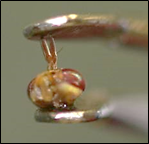| Matthew Siderhurst |

|
Contact InformationUSDA-ARS Daniel K. Inouye U.S. Pacific Basin Agricultural Research Center |
|
Publications
via ARIS system
via Google Scholar
Education
- Ph.D., Colorado State University, 2004
- B.A., Goshen College, 1998
Research Positions
- 2024-present, Research Biologist, Research Biologist, USDA-ARS, Daniel K. Inouye U.S. Pacific Basin Agricultural Research Center, Hilo, Hawai'i
- 2022-2023, Daniel B. Suter Endowed Chair, Eastern Mennonite University, Harrisonburg, VA
- 2018-2023, Professor of Chemistry, Eastern Mennonite University, Harrisonburg, VA
- 2011-2018, Associate Professor of Chemistry, Eastern Mennonite University, Harrisonburg, VA
- 2006-2011, Assistant Professor of Chemistry, Eastern Mennonite University, Harrisonburg, VA
- 2004-2006, Postdoctoral Fellow, USDA-ARS, Daniel K. Inouye U.S. Pacific Basin Agricultural Research Center, Hilo, Hawai'i
Research Accomplishments
My research broadly focuses on the chemistry and behavioral ecology of insects. This includes control applications of semiochemical attractants for pest insects, insect tracking, movement parameterization and modeling, studying plant-insect interactions, and identification and synthesis of plant and insect natural products. Current projects include using harmonic radar to track tephritid fruit flies, synthesis of several potential insect attractants, and analyzing volatiles from coffee and tea.
Harmonic Radar Tracking of Tephritid Fruit Flies
 Tephritid fruit flies are major horticultural pests in many tropical, subtropical, and temperate growing regions of the world. Determining movement parameters for fruit flies is critical to developing models which can be used to increase the effectiveness of surveillance and control strategies. I lead a team that has been tracking a variety of tephritids including, Bactrocera dorsalis, B. tryoni, B. jarvisi, and Zeugodacus cucurbitae. We have developed harmonic radar tags with superelastic nitinol wire antennae. Nitinol has the advantage of being light (some tags weigh less than 350 μg), flexible, and does not easily tangle. Tracking experiments have been conducted in large outdoor field cages, papaya fields, and open grassland. Data from these studies show that tephitid movements are affected by wind, vegetation (grass vs. trees and within- or between-tree), and that they show a high degree of directional persistence. Data on flight directionality and step-distances determined in these studies provide parameters for models that may help enhance current surveillance, control, and eradication methods, such as optimizing trap placements and pesticide applications, determining release sites for parasitoids, and setting quarantine boundaries after incursions.
Tephritid fruit flies are major horticultural pests in many tropical, subtropical, and temperate growing regions of the world. Determining movement parameters for fruit flies is critical to developing models which can be used to increase the effectiveness of surveillance and control strategies. I lead a team that has been tracking a variety of tephritids including, Bactrocera dorsalis, B. tryoni, B. jarvisi, and Zeugodacus cucurbitae. We have developed harmonic radar tags with superelastic nitinol wire antennae. Nitinol has the advantage of being light (some tags weigh less than 350 μg), flexible, and does not easily tangle. Tracking experiments have been conducted in large outdoor field cages, papaya fields, and open grassland. Data from these studies show that tephitid movements are affected by wind, vegetation (grass vs. trees and within- or between-tree), and that they show a high degree of directional persistence. Data on flight directionality and step-distances determined in these studies provide parameters for models that may help enhance current surveillance, control, and eradication methods, such as optimizing trap placements and pesticide applications, determining release sites for parasitoids, and setting quarantine boundaries after incursions.
Cucumber lure for Zeugodacus cucurbitae and Z. cucumis

Chemical lures are a key technology in the control of economically critical tephritid fruit flies worldwide. Attractants for female fruit flies are of particular interest as they could be used in control tactics to reduce pest levels. With collaborators in Hawaii and Australia, I used coupled gas chromatography-electroantennogram detection to identify a synthetic cucumber-based lure that attracts male and female Zeugodacus cucurbitae and Z. cucumis. Field testing in Hawaii, Australia, and Taiwan have shown that the lure generally captures more flies than other treatments tested including twice the captures of traps baited with solulys protein bait. Besides having a female-biased attraction, this lure may have several advantages over protein baits: it can be used with a dry trap, is long lasting, and it captured low numbers of non-target species. Possible applications of this lure include trapping (for detection and/or monitoring/delimitation) and control/ eradication (e.g., mass trapping, attract-and-kill, or as an attractant for existing protein insecticide bait sprays such as GF-120).
Radio Telemetry Tracking of Pest Insects

Tracking individual pest insects in the wild can both improve our understanding of insect movement (leading to better control methods) and in some cases be used directly in control strategies. Working with collaborators in USDA APHIS, the University of Guam, and DAF Queensland, I have used radio tags to track fruit piercing moth coconut rhinoceros beetle (CRB), and the spotted lanternfly (SLF). For SLF, both adults and fourth-instar nymphs were tracked during the course of a field season. Individual SLF were observed to move over 400 m with the longest distances moved by females between the first field observation of mating and two weeks after the first fresh egg mass was found. SLF height in trees was found to vary over the study period. With CRB, we showed that tracking can be used as part of a control program. The ‘Judas technique’, tracking conspecifics to hidden or cryptic pest populations, has been employed to control larger animals and we showed that with tag miniaturization, it is now possible to apply this technique to large insects. We demonstrated this by performing tracking experiments at two locations in Guam to test the feasibility of using the ‘Judas technique’, releasing radio-tagged adults to discover cryptic breeding sites, for potential coconut rhinoceros beetle control. Of 33 radio-tagged beetles that were released, 19 were successfully tracked to landing sites, 11 of which were considered to be active or potential breeding sites, in five different microhabitats.
Fluorinated Attractants for Tephritid Fruit Flies
 Lures that attract male fruit flies are important for the detection of incursions and outbreaks, monitoring of populations, and control by mass trapping and male annihilation. Arguably the two most important male lures are methyl eugenol (1,2-dimethoxy-4-(prop-2-enyl)benzene, ME) and cuelure (4-(3-oxobutyl)phenyl acetate, CL). Along with colleagues from USDA ARS and Macquarie University, I have worked to synthesize and test fluorinated analogs of ME and CL either to potentially decrease human toxicity or improve volatility and attraction of pest flies. One such lure is a novel fluorinated analog of raspberry ketone, raspberry ketone trifluoroacetate (RKTA). Laboratory cage bioassays and field trapping experiments have shown RKTA be to highly attractive to Bactrocera tryoni and Zeugodacus cucurbitae. However, RKTA hydrolyzes relatively quickly under field conditions and therefore has only a short attractive lifetime in the field. A second set of lures I’ve worked to make are fluorinated ME analogs. These analogs helped probe the metabolism of ME in B. dorsalis with potential for further development of toxicants that could be used against this pest.
Lures that attract male fruit flies are important for the detection of incursions and outbreaks, monitoring of populations, and control by mass trapping and male annihilation. Arguably the two most important male lures are methyl eugenol (1,2-dimethoxy-4-(prop-2-enyl)benzene, ME) and cuelure (4-(3-oxobutyl)phenyl acetate, CL). Along with colleagues from USDA ARS and Macquarie University, I have worked to synthesize and test fluorinated analogs of ME and CL either to potentially decrease human toxicity or improve volatility and attraction of pest flies. One such lure is a novel fluorinated analog of raspberry ketone, raspberry ketone trifluoroacetate (RKTA). Laboratory cage bioassays and field trapping experiments have shown RKTA be to highly attractive to Bactrocera tryoni and Zeugodacus cucurbitae. However, RKTA hydrolyzes relatively quickly under field conditions and therefore has only a short attractive lifetime in the field. A second set of lures I’ve worked to make are fluorinated ME analogs. These analogs helped probe the metabolism of ME in B. dorsalis with potential for further development of toxicants that could be used against this pest.
Developing Attractants for Invasive Insects that Effect Hawaii

I have led several projects aimed at rapidly developing attractants for a number of invasive agriculturally-important insects in Hawaii, most notably pheromone lures for the little fire ant (LFA), Wasmannia auropunctata, the nettle moth (NM), Darna pallivitta, and the banana moth (BM), Opogona sacchari. In each case I was responding to the need for detection and control tools by identifying pheromone attractants that could be used by action agencies. Additionally, I’m interested in moving beyond simply identifying and synthesizing the pheromones to conducting research demonstrating the field applications of these pheromone attractants. For NM this meant conducting experiments on mating disruption and population monitoring. For LFA this has meant the development of species-specific one-way pheromone traps and studying the distribution of ants in the field. The high species specificity of the one-way trap, in combination with an attractive pheromone, has the potential to be a species-level tool for non-specialists to implement biodiversity monitoring programs. Using pheromone traps might enable members of the public to simply report the presence or absence of ants such as LFA without creating a large number of samples to be examined by trained taxonomists.
Service, Leadership and Participation in Professional Activities:
- Councilor for the Asia-Pacific Association of Chemical Ecologists (2017-2019)
- Member, Entomological Society of America
- Member, International Society of Chemical Ecology
- Member, American Chemical Society
- Member, Asia-Pacific Association of Chemical Ecologists
- Peer reviewer: Journal of Economic Entomology, Journal of Chemical Ecology, Environmental Entomology, Journal of Insect Science, Organic Letters, Insect Science (Entomological Society of China), Journal of Applied Entomology, Journal of Undergraduate Chemistry Research, Entomologia Experimentalis et Applicata, Agricultural and Forest Entomology, European Journal of Entomology, Philippine Journal of Science, Journal of Natural Products, Scientific Reports, Insectes Sociaux, Insects, Communications Biology, Planta, and Food Control
- Eastern Mennonite University Service: Faculty Status Committee (elected committee), NCAA Faculty Athletic Representative, Student Government Association Faculty Representative, Coordinated Community Response Team (sexual violence prevention), Homecoming Committee, Honors Committee, Take Back the Night organizing committee, Ultimate Frisbee Club faculty advisor, Faculty Senate (elected committee), Faculty Scholarship Committee (elected committee), Admissions Committee, Undergraduate Enrolment Strategies Group, and Chemical Safety Committee
Honors, Awards, Achievements and Recognition:
- ARS Research Participation Program (established scientist 2016)

